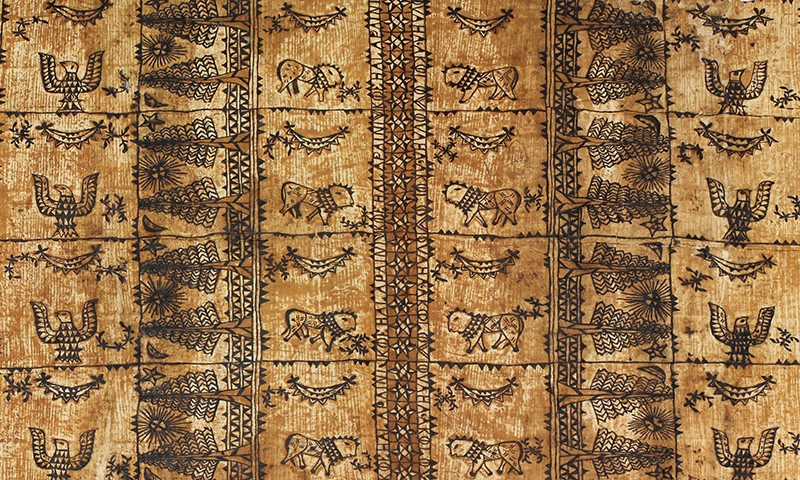 |
Detail of Tapa Cloth (Ngatu), 20th Century
Tongan culture; Tonga, Polynesia
Pounded tree bark and pigment; 78 x 152 in.
93.18.1
Donated by Jeff and Laura Blackie |
Cloth With a Bark
Tapa cloth, a barkcloth made from the inner bark of trees, is one of the most distinctive products made by the cultures of the Pacific Islands and remains at the heart of Pacific Islander identity. Indeed, the creation of tapa cloths is directly connected to the very origins of Pacific Island culture. From what little archaeological evidence remains, scholars argue that the skill of making barkcloth was carried out of South-East Asia by the first peoples to migrate to the South Pacific islands. As these peoples settled on islands they discovered, they developed their own variations of tapa production and symbolism to better fit their changing cultural needs. Tapa creation has continued to evolve throughout the history of the Pacific Islands and remains an important aspect of their society, religion, and culture today.
 |
| Detail of 93.18.1 |
Sewing the Seeds of Identity
The two tapa cloths featured in the Bowers Museum collection were purchased in the 20th century in Nuku’alofa, the capitol of Tonga, a Polynesian kingdom of more than 170 islands. As is true for other Pacific Islander cultures, Tongan tapa--or ngatu as is it referred to by the Tongans--maintains a profound connection to the origins of the Tonga identity. The Polynesian tapa tradition likely originated from the Lapita people who explored the Pacific roughly three thousand years ago. Art historians and anthropologists have argued that the same patterns used on Lapita pottery, barkcloth, and possibly tattoos are still evident in the ngatu made in Polynesia today. The Tongans continue to be the most prolific tapa producers in the Pacific and the world.
 |
Details of Tapa Cloth (Ngatu), 1930
Tongan culture; Nukuʻalofa, Tongatapu Island, Tonga, Polynesia
Pounded mulberry tree bark and pigment; 74 x 108 1/2 in.
2000.32.1
Gift of Rene Kamin |
Pattern of Production
The Kingdom of Tonga is particularly well suited to the production of tapa cloth because their climate and soil conditions are ideal for the cultivation of paper mulberry (Broussonetia papyrifera), a common source of barkcloth. The fabrication of ngatu begins with stripping the bark from the tree, separating the inner from the outer bark, and then beating the inner bark on a long anvil (tutua) to spread the fibers. The small pieces of beaten cloth (feta’aki) are then joined together to make the full sized ngatu. The tedious work of combining the feta’aki is done by groups of women who use the time to also exchange important news and tell stories. Using a convex bench and patterned rubbing blocks (kupesi), two women sit across from each other to rub the surface of the cloth with a brown pigment so that the pattern from the rubbing block below is transferred onto the feta’aki (similar to using a pencil to create a rubbing of a texture on paper). Half-cooked arrowroot tubers are then used as a bonding agent. This process is continued with the remaining feta’aki, alternating the between laying the strips horizontally and vertically, until the ngatu has reached the required length. The finished cloth is then dried in the sun and slept on for several nights until it becomes flat. Finally, brown or black dye is used to further highlight the patterns.
 |
| Entirety of 93.18.1 |
There are a very wide range of abstract and naturalistic motifs used on Tongan tapa. Tonga is also one of the few, if not the only culture in the Pacific to also use tapa motifs to document historical events. In 1910, for example, the shooting star motif was frequently used to commemorate the appearance of Halley’s Comet.
 |
| Alternate view of 2000.32.1 |
The Fabric of Life
The functions of ngatu in Tongan culture are diverse. When Captain James Cook first visited the Tonga in the 18th century, tapa was used for a wide range of everyday purposes ranging from clothing to bedding to bandages. Although the Tongans have worn Western-style clothing for many years, ngatu are still occasionally used as waist mats for important events. Barkcloth has been used in Tongan ceremonies such as commemorations, weddings, and funerals for thousands of years. On such occasions, especially when a royal family is involved, a single ngatu cloth may extend up to 100 meters (although some reports describe ngatu that are a mile long). These monumental stretches of barkcloth are used to line processional pathways, to be carried as presentation pieces, or to be held up by people to form a type of three-dimensional sculpture site. In the course of these performative and presentational acts, the ngatu take on a sacred significance essential to the ritual’s realization.
Guest authored by Jessica Bocinski, Intern for the Bowers Museum's Collections Department, with some text taken from the 2006 Bowers Blog post, Tongan Tapa Cloth. Text and images may be under copyright. Please contact Collection Department for permission to use. References are available on request. Information subject to change upon further research.







Comments 3
Thank you for this piece on ngatu from Tonga.
Very interesting article. I have what I believe is a Tongan Ngatu. Am searching for information. Thank you.
I am requesting for a method that can softening the barkcloth so as to make dresses out of it.
Regards
Josephine